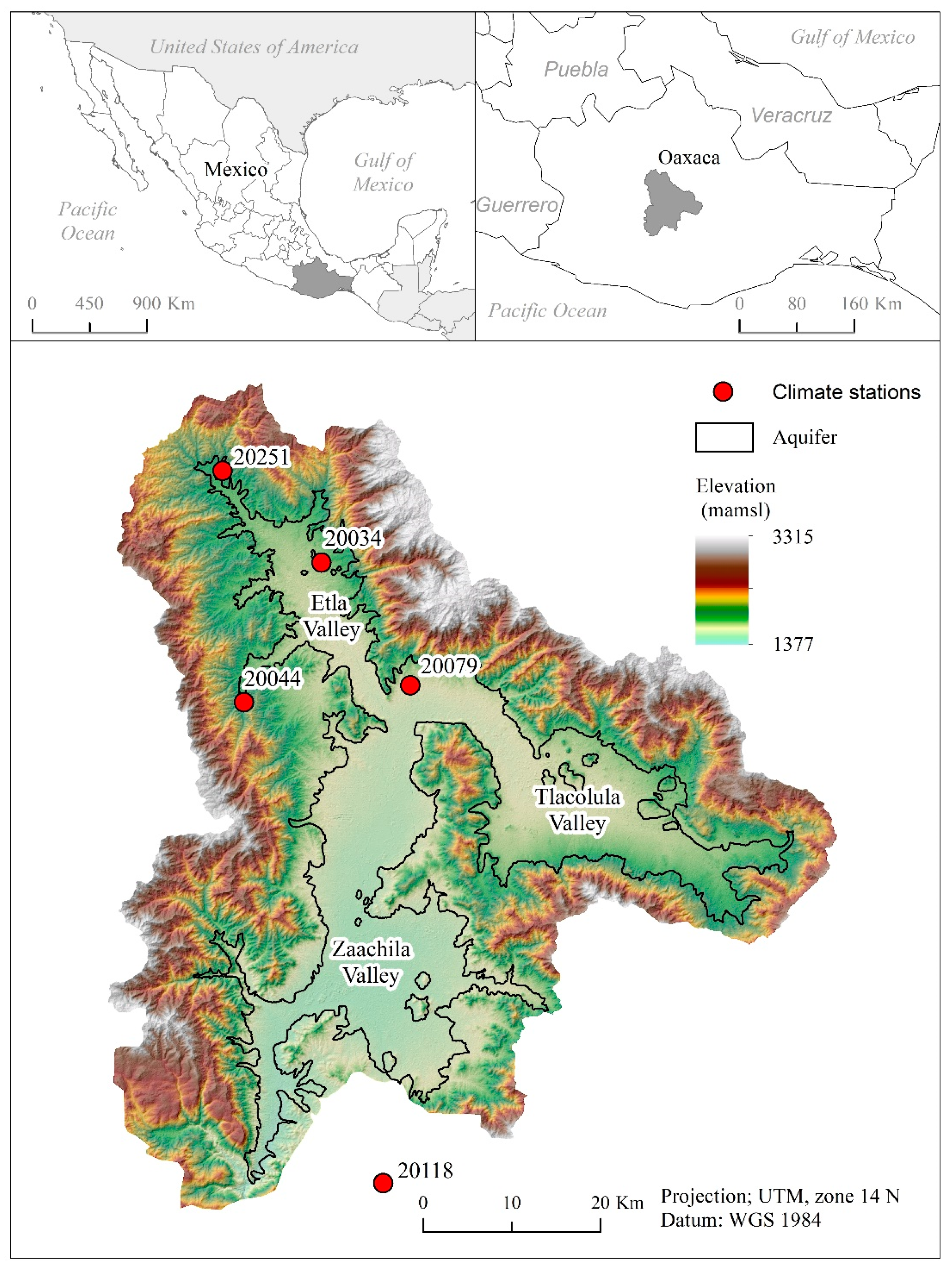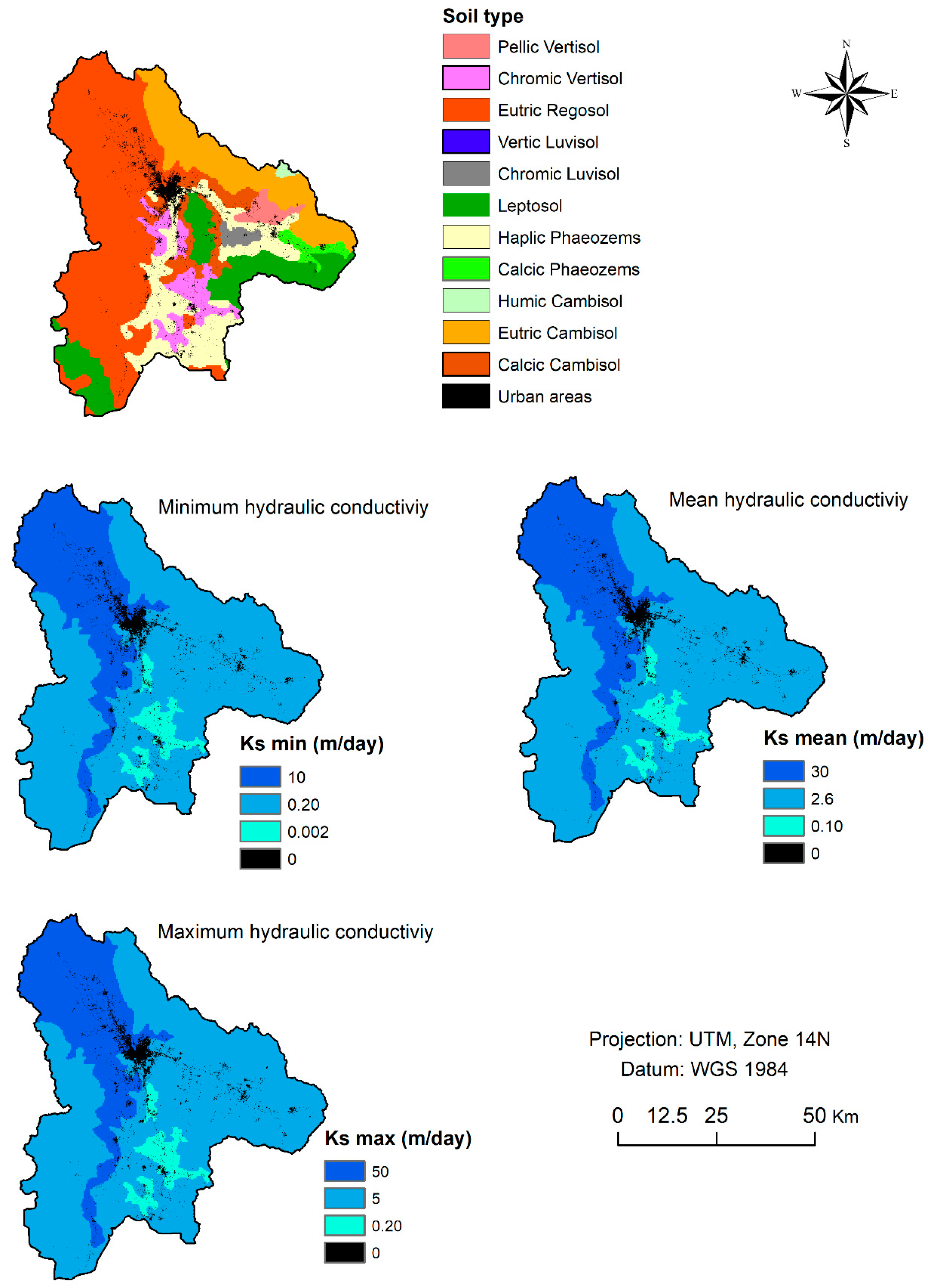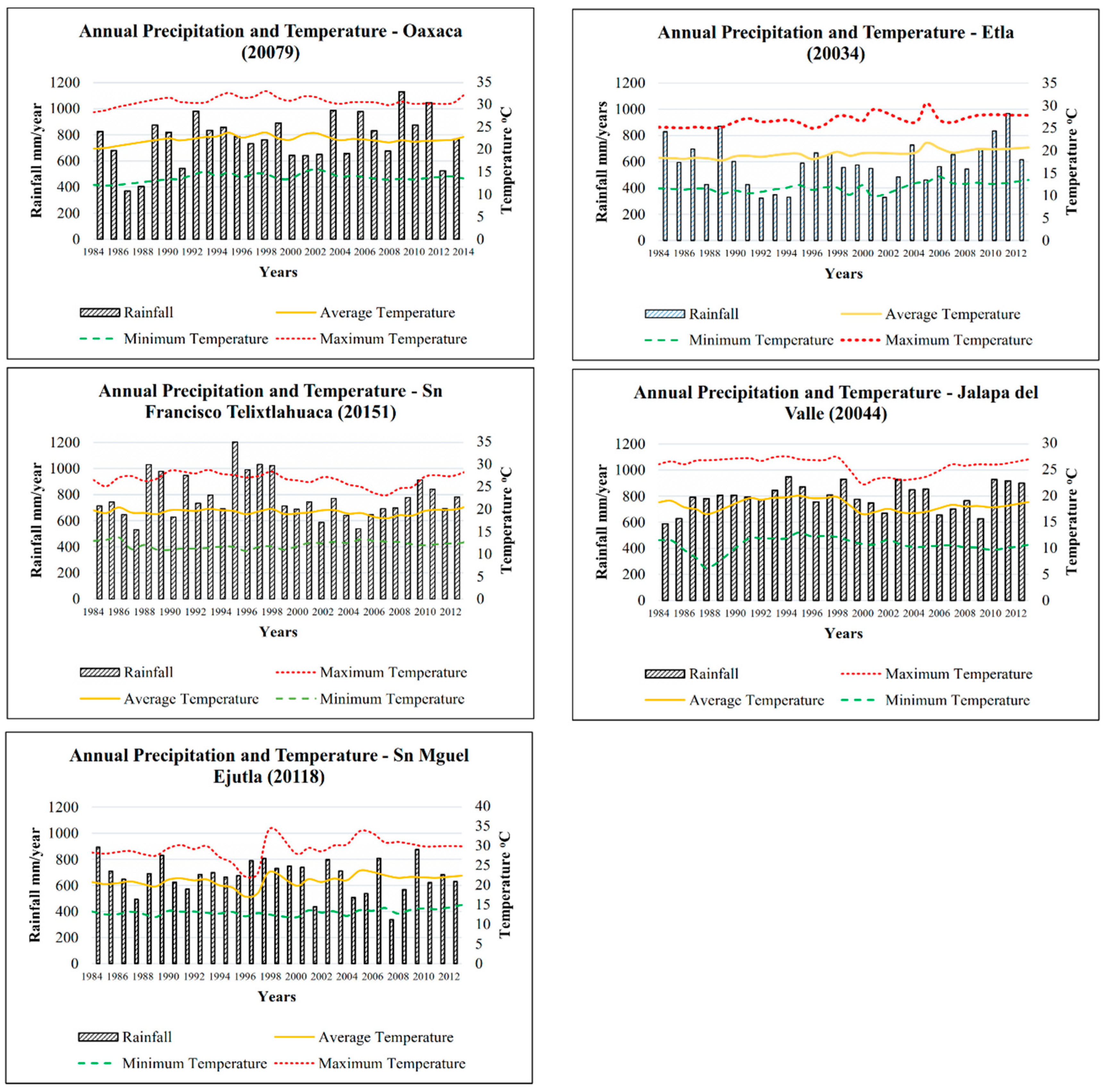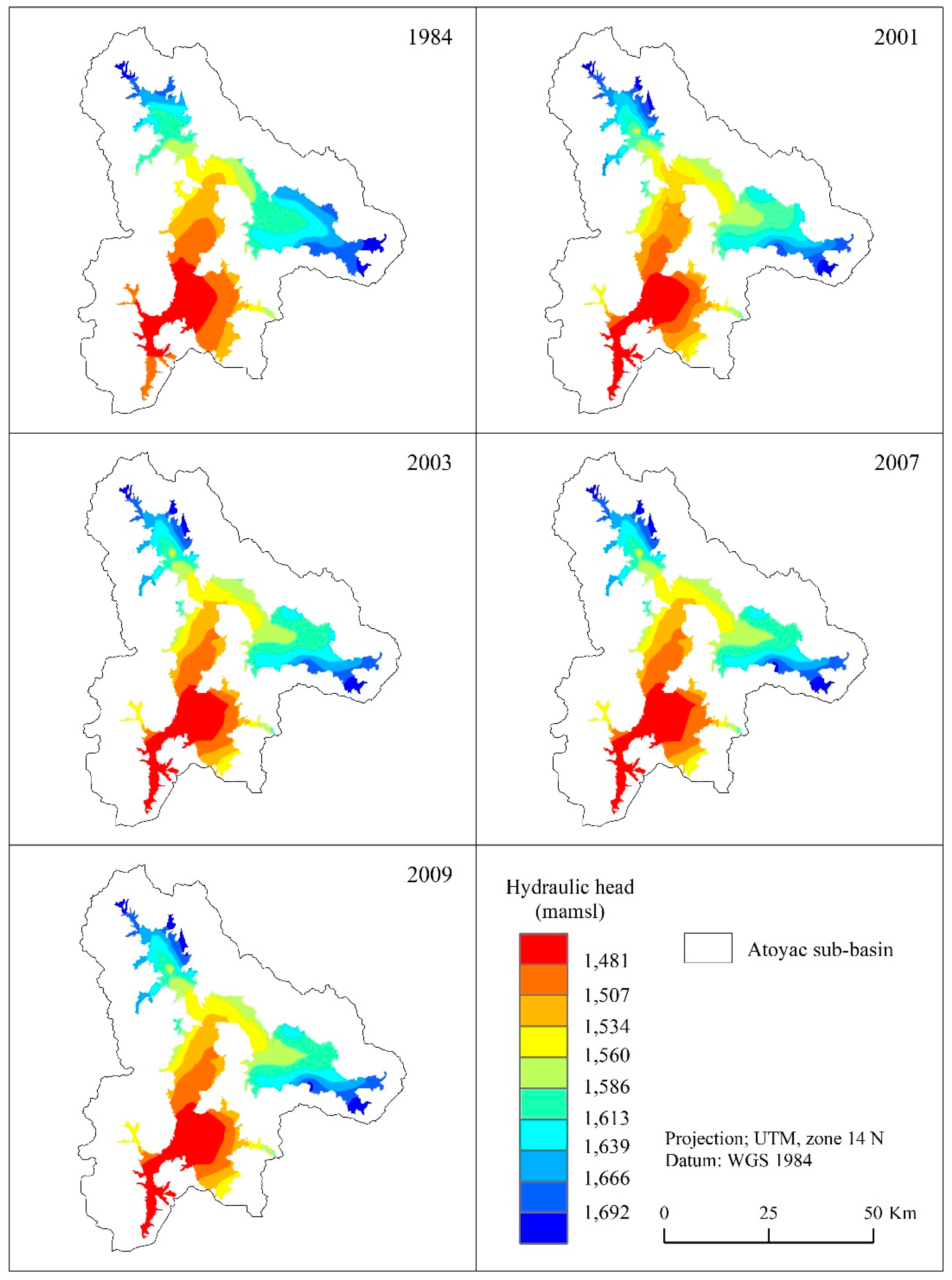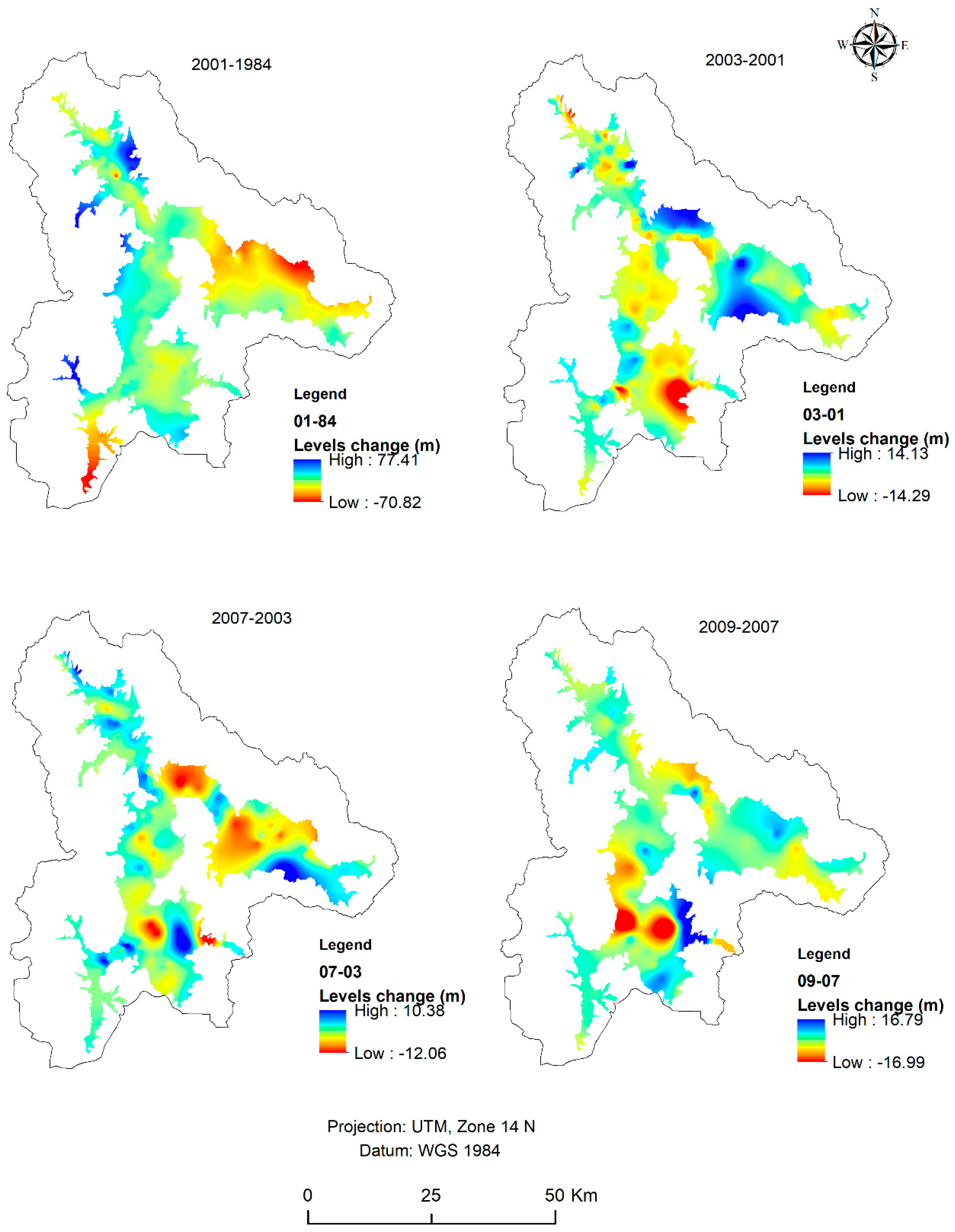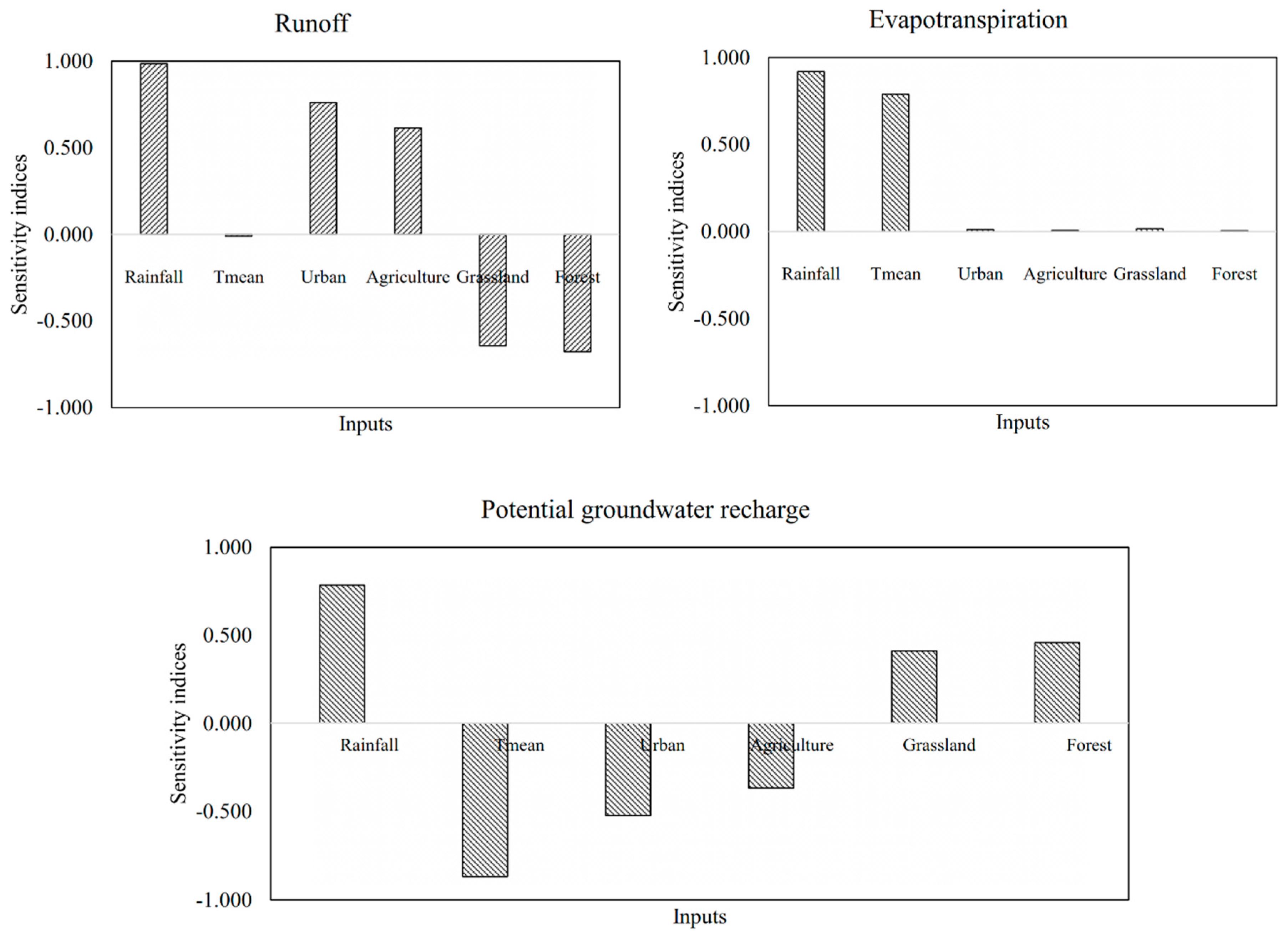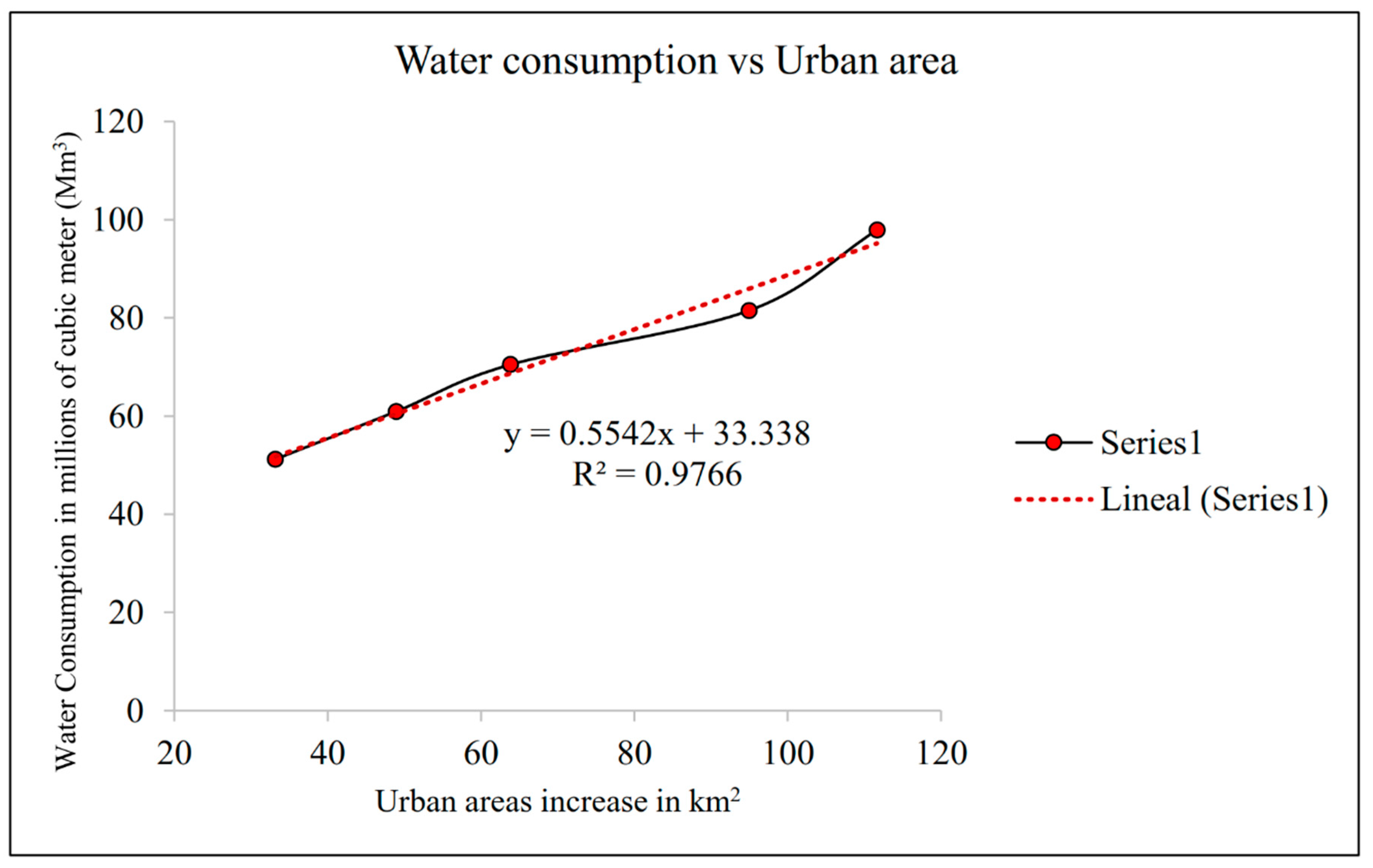1. Introduction
Groundwater is a complex component of any region’s hydrological system. Detailed information and descriptive data of the volumes, extent, and quality of groundwater supplies is usually very limited. What is known about the groundwater resources of a region is often sketchy and uncertain. Groundwater is storage of fresh water in aquifer systems which are subterranean layers of water-bearing permeable rock or unconsolidated materials. According to Arnell [
1], the processes that control the recharge (
Re) ratios in aquifers are climate, topography, and the geological structure. Precipitation (P) provides the input into the aquifer system. Hydrological soil conditions control infiltration of water to the water table. However, the geological framework determines the capacity for water to flow at depths and can slow recharge rates. If the climatic and soil conditions generate
Re in excess of the capacity of the saturated matrix to transmit the
Re, then the permeability of the geological characteristics controls
Re rates [
2]. The water balance (aquifer inflows and outflows) can be defined as the volume that is required to sustain groundwater use and groundwater-dependent ecosystem services for a region of interest, which could be delimited as an aquifer, a watershed, or a community [
3]. Many social, economic, and environmental processes influence groundwater quantity and quality, and these systems are often difficult to predict. They therefore increase the complexity of groundwater management. Populations of every region of the world rely to some extent on groundwater. Due to its complexity, groundwater is a system that, once degraded, is very difficult to repair [
4]. Groundwater is a vital source of fresh water for residential uses and for agriculture [
5,
6,
7], and it plays a fundamental role in economic and food security [
8]. Agriculture uses more freshwater than any other economic sector or activity. It accounts for about 70% of global freshwater withdrawals and 90% of freshwater consumption. Irrigation consumes 545 km
3 of groundwater per year. Groundwater provides 43% of water consumed (1277 km
3) for irrigation ever year [
5].
Water scarcity is a widespread and challenging problem in Mexico, regularly presenting moderate and severe scarcity from February to May or June [
9]. The problem has worsened dramatically over the last three decades. In the Central Valleys of Oaxaca, two forces are the main drivers of increasing groundwater demand: agriculture, the main economic activity using groundwater (more than 80% of groundwater is used for agriculture), and population, which has increased by about 76% since the 1980s. Agriculture in Oaxaca has experienced abandonment due to poverty, and rural-to-urban migration has increased the pressure of urban water demand on rural groundwater supplies. Changing consumption habits and low-tech irrigation infrastructure have also intensified the pressures on groundwater. Climate change (CC) is now an additional stress. In combination with population growth and redistribution, and land-use and land-cover (LULC) changes, shifts in weather patterns and increasingly unanticipated shifts in components of climate magnify stresses on freshwater supplies [
10,
11,
12,
13,
14,
15]. The pressures are so great that some parts of the Central Valleys of Oaxaca are experiencing significant pollution problems due to overexploitation, poor waste management infrastructure, and shrinking aquifers.
New tools and techniques are needed to extract and analyze data to evaluate present and future groundwater conditions. Probabilistic tools to determine the sensitivity and uncertainty of the analytical innovations can provide some insight. LULC changes can be used to assess the trends in groundwater supplies. Remote sensing can be used to determine where those changes are greatest in order to fill in data gaps. Water table monitoring at wells provides instantaneous assessments of the effects of
Re and extraction. Water table point data must be spatially extrapolated to visualize regional change. Therefore, geostatistical methods are vital for data analysis. The distribution and quality of field data dictates the best methods to use. Kriging, for example, is an interpolation method that has been used in many groundwater studies [
16,
17,
18,
19,
20,
21]. Kriging can be applied to a small and sparsely distributed observation sample and yields error estimates to characterize the accuracy of its output.
Assessing the hydrological effects of climate change, LULC, and population growth is of vital importance for land use planning and water resource management. Especially because groundwater supports drinking water for the population and irrigation for agriculture in the Central Valleys of Oaxaca. This research combines empirical data from a network of wells, remotely sensed data, groundwater models, and a geographic information system (GIS) for data management and analyses of historical patterns of groundwater uses, demands, and supplies in the Central Valleys of Oaxaca in order to spatially predict the future demands and supplies in the contexts of anticipated growth and change of population, land use and land cover (LULC), and climate. The results can help pinpoint areas that may (or may not) contribute sufficient Re to meet the future demands for groundwater in the region. Such knowledge can aid planning for engineered Re infrastructure for selected zones and the use of irrigation management strategies with effective water-consumption policies that achieve water supply goals.
Study Area
The study area is a basin located between 16°30′ and 17°25′N and 96°15′ and 97°00′W. Three valleys in the basin, the Etla, the Tlacolula, and the Zaachila (from Zimatlán to Ocotlán), are collectively referred to as the Central Valleys of Oaxaca (
Figure 1). The Central Valleys border the Mixteca region to the west, the Cañada region to the northwest, the Sierra de Juárez to the north, the Tehuantepec Isthmus region to the east, and the Sierra Madre del Sur to the south. The Alto Atoyac sub-basin has a surface area of 3744.64 km
2, with an approximate aquifer surface of 1130 km
2, the annual
Re ranges from 153.6 to 169 million m
3 [
22], with an average annual P (P) of 741 mm/year and annual average temperature (T) of 19.96 °C. The region’s bedrock includes metamorphic gneiss and schists, limestones, and rhyolites. The metamorphic rocks and extrusive volcanic rocks constitute the impermeable borders of the sub-basin [
22] (for more detail of the geology see [
23] and [
24]. The 396 km long Atoyac River is the main river course through the Central Valleys.
Agriculture is the main economic activity of the rural portions of the sub-basin, particularly in the Zaachila and Etla Valleys, the two largest agricultural districts. Agriculture is estimated to use 87.6% of the groundwater of the study area [
22]. The aquifer of the Central Valleys is unconfined and is composed of alluvium, a heterogeneous mixture of unconsolidated sediments. Its thickness ranges from 15 m to 100 m, thinning toward the basin’s edges. The region’s water table is shallow (0.2 m to 20 m) and there are areas of high permeability (
Figure 2). Intensive agriculture in the region has increased the likelihood of overexploitation. A large depletion cone has been identified in the Zaachila Valley.
4. Discussion
P and T are two important aspects of the water cycle that dictate the condition of water resources. They link local environmental conditions and changing climate to regional water resources. Changes in P and T patterns will affect the distribution of water over space and time [
46]. Many studies have projected increased water demand due to CC, increasing water scarcity in many regions over the next several decades, and enhancing the intensities of extreme events (like droughts and floods) in the water cycle. Weather extremes are expected to increase every year [
46,
47,
48,
49,
50]. Even without a clear linear relationship between T and P in the climate models, increasing T is believed to promote P [
51,
52,
53,
54]. However, there is a significant amount of uncertainty in these relationships.
Increasing P extremes and increasing T can be related to the absence of a moisture-limitation in the Clausius—Clapeyron relationship [
54,
55], which calculates the water-holding capacity of the atmosphere. In the study area, since 1984, the variation of T and the frequency of extreme P events in the study region have both increased. These changes directly influence the water cycle and the water balance. Increasing T augments ET, so increases of mean annual T from 2 °C to 4.95 °C can be extremely impactful on groundwater resources by reducing the rate of recharge. Even if P increases, flooding can overwhelm a soil’s infiltration capacity.
Since 2013, it has been evident that the effects of LULC change should be incorporated into climate-change studies [
56]. The water in a basin is controlled by climatic factors and features of the basin (LULC and soil type, hydrogeological conditions). To quantify the combined effects of LULC and CC on water resources is a challenge because LULC affects water availability by altering hydrological processes through modifications of ET, soil moisture dynamics [
57,
58], and
.
The impervious surfaces of urban land use can cause land degradation and increase
[
57,
59] in a region, even if the
is primarily dictated by agricultural land (which represents 38.28% of the study area). Because water demand for crops is usually high, the increase of urban cover is a challenge for water resource management. As both water consumption and
rates are increasing, augmenting water demand intensifies pressure on the resource. Urban areas represent a small percentage of the total area but are still a major influence and determine supply by increasing
in the sub-basin.
has increased 1.69 mm from 1986 to 2018. From 1984 to 2002, agriculture land area increased, but from 2002 to 2010, the total farmland area decreased. Farms were converted to urban use. The same process occurred throughout Mexico during this period due to socio-political conditions that caused abandonment of farms between 2000–2006. Many farmers migrated northward and into cities (to cities in Mexico and the United States) for better economic opportunities.
The increase of impervious surfaces (urban areas) doesn’t allow soil infiltration of P or
Ru. Streets, channels, and drainages funnel storm water into waterways, and leads to a decrease in infiltration and an increase of runoff [
60]. Urban environments significantly alter the recharge [
61]. The effect of urbanization on water recharge is complex and the impact will depend on the features of the area, construction density, infrastructure to manage storm water, sewage systems, and water supply infrastructure [
62]. However, the effect of urban growth can be mitigated by reducing evapotranspiration rates, and other, maybe new, matters may consequentially enhance recharge in some urban environments, such as leaks from sewage and water distribution systems and directing runoff into recharge infrastructure [
45,
63]. Unfortunately, urban growth is usually caused by population growth, which increases groundwater abstraction to meet the increasing water demand, and this can lead to increasing groundwater depletion. Another problem is that decreasing ET reduces consumption of latent heat. Therefore, more energy is available as sensible heat, which results in higher land surface temperatures [
64], which can decrease precipitation, and increase the length of the dry season [
65,
66,
67,
68]. In the long term, increased urban land use can diminish the size of the recharge area, increase potential evaporation rates, and increase the length of the dry season.
Water balance is sensitive to the changes in climatological data and basin conditions, which is, in this case, changing LULC. Increasing urban and agricultural LULC accelerates the rate at which
is rising. Because the percentage of the region that has urbanized is small compared to the other LULC categories, the
contribution of urban areas is small. T
mean, urban, and agricultural covers are inversely related to
Re, indicating that increases of this factors could lead to reductions in
Re in the study area. Considering that ET is one of the parameters with a higher weighting in the water balance and LULC changes, it also induce changes in ET rates. For every LULC category, changes are inversely related to ET: increasing urban areas can decrease ET and decreasing forestland also decreases ET, as mentioned above. Less ET means more R
u and increases the likelihood of Re [
46]. ET was not calculated for forest, urban, and grassland land uses and was not included in the analysis. This a limitation of the method because it is a limited consideration of the impacts of the other three LULCs. This underestimates the real effect of LULC on ET in the study. This could be the basis for future research that more closely examines the relationships between LULCs and ET in the study area.
Sensitivity analysis with the empirical values measured at the five meteorological stations (139 inputs) is not sensitive to changing forest area because it has not changed much in the study area, and results will indicate that increases in forest will produce increases in runoff. Nevertheless, ET sensitivity analysis indicate that increase in urban areas and decrease in forestland can promote
Re (PRCC values of −0.1222 and 0.002 for urban and forestland), but these values are not significant. Similar values are found in Minnig,
et al. [
45] and it can most likely explain the R
e trend from 1986 to 2013, which increases by 72.29 mm/year.
Changing Water Tables and Depleting Aquifers
Since 1984, depletion cones have become apparent throughout the sub-basin. Over the last 25 years, the Tlacolula Valley’s water table has fallen 38 m. In the Etla Valley, the aquifer has fallen between 29 m and 44 m. In the Zaachila Valley, the depletion is 25 m. There is constant pressure upon the groundwater, which is evident by what the annual extraction volume has done to the hydraulic head. The extracted volume in 1984 was 115.53 × 10
6 m
3 and in 2009 it was 331.8 × 10
6 m
3. By 2009, the extraction rate surpassed the annual
Re rate of 169 × 10
6 m
3 [
22]. Over the same period, consumption nearly doubled from 47.54 × 10
6 m
3 in 1984 to 80.04 × 10
6 m
3 in 2009 (a calculation based on an average water demand of 216 LPD). This depletion is due to CC, intensified T, urbanization, and the increasing extent of impervious surfaces. Consumers of water in the study area are extracting more water from the aquifer than is available to
Re due to increasing
and higher ET.
There is relationship between urbanization and water consumption since the latter is tied to population growth. The negative effects of population on water resources are numerous [
10], as the water input into the aquifer has diminished and the water demand for different uses increases. If continued, a 2.3% annual population growth rate will cause great pressure on water resources over the coming decades; this is borne out by the projections examined here. One potential solution that can be inferred from the projections is to reduce water consumption to a per-person average of less than 50 LPD.
Water is a particularly vital resource in this region. It is the engine of the economy in both urban and rural areas which are based on small business, tourism, agriculture, forestry, and ecotourism. In the last decade, insufficient water supplies have become notorious, but research on this problem has been very limited. It can be said that economic activities and population growth have increased environmental problems by the overexploitation of groundwater over the last 25 years. Some scholars have indicated that groundwater exploitation has yielded economic growth around the world over the last five decades, but it has also yielded significant social and environmental costs [
69,
70]. One future consequence that may arise in the area due to overexploitation of groundwater is subsidence of land surfaces; this is already happening in some regions of Mexico due to overexploitation of aquifers [
71,
72,
73].
5. Conclusions
Over the 34-year period of analysis, water recharge in the study area has been driven primarily by climatological conditions in the sub-basin, especially the variations in rainfall and temperature, which are the main variables of the water balance calculation. There has been little change in the proportions of LULC categories; only urban area has increased significantly due to population growth over the last three decades. Runoff from urban areas increased, but the change was relatively small, from 1.45% in 1986 to 4.84% 2018. Thus, although urban areas increased in size and runoff amount, the largest contribution still comes from agricultural areas. Agricultural land use comprises 31% of the total sub-basin. Together, the impacts of agriculture and urban land use demonstrate the direct impact of human activities on groundwater resources in the Central Valleys of Oaxaca: population growth leads to increasing abstraction of continuously shrinking supplies of groundwater.
Groundwater is a high-risk resource due to fluctuating Re rates and human activities. High levels of exploitation put all users into precarious positions, and this is demonstrated by the projections of future groundwater supplies and trends in groundwater extraction. The main threats in the Alto Atoyac sub-basin are CC, LULC change, and population growth.
Climate data indicate that despite increases in annual P, rising average annual T and increasing ET rates will produce diminishing Re of groundwater resources for the future. According to the RCP4.5 climate-change scenario, mean annual T is projected to increase over the near, middle, and distant future by 1.46 °C, 2.49 °C, and 3.02 °C, respectively. This is likely to intensify ET rates by 1.86%, 3.49%, and 5.56%, respectively. The increases of 1.49 °C, 3.21 °C, and 4.95 °C projected by the RCP8.5 model will yield increases of 2.78%, 5.97%, and 8.18% in ET rates.
LULC change and shifting patterns of T are the main influencers of the water Re changes. Increasing T and urbanization enhance both ET and and allow for less potential Re of aquifers. From 1986 to 2018, mean annual T increased 1.76 °C and the urban LULC increased 2.3 km2/year. Projections under the RCP4.5 and RCP8.5 scenarios show that the Re rate will diminish to the first horizon by 35.48% and 44.47 %, respectively. At the most distant horizons of both scenarios, potential Re is projected to decrease 67.69% (RCP4.5) and 86.56% (RCP8.5), indicating that there will be groundwater availability problems in the future.
As urban areas increase, population will increase and so will the demand for fresh water. There will be a negative consequence on groundwater because of the concomitant increased and magnified extraction of groundwater to meet basic needs. From 1986 to 2018, increased at a rate of 0.24 mm/year in urban areas. The in the urban portions of the study area, which are only 2.86% of the total area, increased by 236% (from 1986 to 2018). Water demand grew from 47.54 × 106 m3 to 97.93 × 106 m3 for the same period, which clearly demonstrates the implications of urbanization and population growth for water supplies.
Water balance is sensitive to climate variation, indicating the effects that CC can have in the study area. Physical changes consequential to LULC change have significant effects on the water balance, too. Increases of urban and agricultural areas can generate inverse changes of Re, and they can generate negative consequences in the future. Agricultural areas are expected to shrink in the area due to farm abandonment and urban expansion into rural areas.
Groundwater volumes are being depleted at a rate of 284.34 × 106 m3/year, a deficit of 115.34 × 106 m3/year (a reduction in the groundwater levels of 0.1 m/year). This is consistent with the increased water demand of the last few years and with reduced Re stemming from changing LULC and increasing T.
Some ways to confront these challenges could be to strategically protect Re zones from urbanization, to undertake small-scale engineering projects that enhance Re rates in areas prone to , and to reduce water consumption rates throughout the basin to below 50 LPD to ease the pressure upon the region’s groundwater resources.
